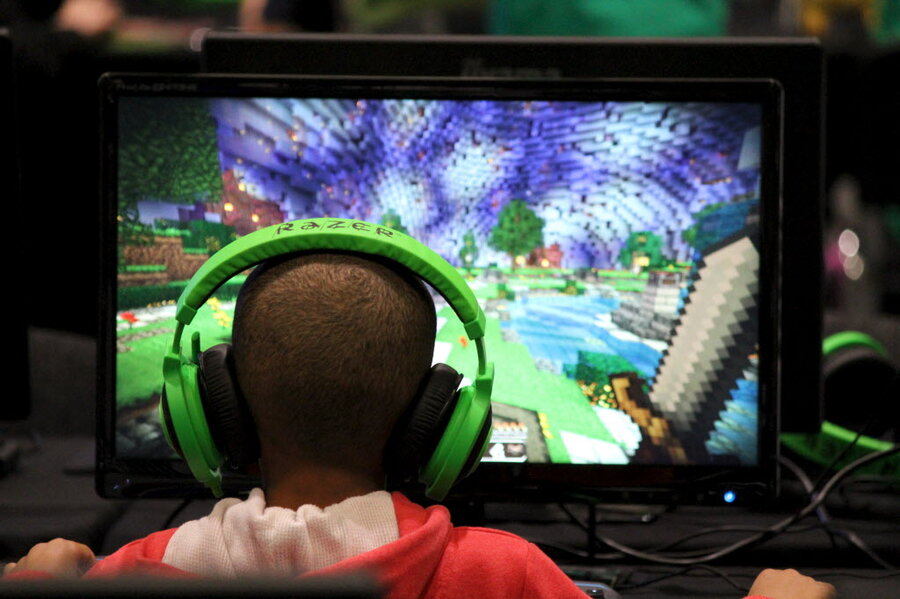Minecraft in school? How video games could be the future of learning
Loading...
Math, geography, art, design – these are just some of the things that children can learn from the popular video game Minecraft, a new study shows.
Essentially a kind of digital Lego through which users can create their own building-block worlds, the game has the potential to engage students in problem-solving, research, creative thinking, and even social interaction, say the Australia-based researchers. Their findings add to a growing body of research supporting not only the use of video games in classroom learning, but also the idea that learning is less an exercise in one-time memorization than an exciting, continuous experience.
“We've seen some real success with engagement, problem solving… with design and their creative work,” Michael Dezuanni, assistant professor at Australia’s Queensland University of Technology and the study’s co-author, told the Australian Broadcasting Corporation.
Professor Dezuanni and his team observed and interviewed 8- and 9-year-old students in Brisbane who regularly played Minecraft at home and at school. They found that the game helped the students analyze math problems, collaborate on projects, and engage in rich social interaction as they discussed their individual processes and results.
“The teachers working with those students have been quite impressed by the way students work with the game, as well,” Dezuanni said.
Video game learning is not a new idea. As early as the 1980s, developers saw the potential of computers as tools for exploratory and experiential learning – though the idea picked up steam just in the last decade, as academia began to view video games as viable educational tools, says Scot Osterweil, educational game designer and creative director of the Massachusetts Institute of Technology’s Education Arcade.
When paired with other hands-on activities and instruction, Mr. Osterweil says, video games have the potential to help students understand and interact with complex computational systems, such as the human body, that are traditionally taught piecemeal.
This encourages students to understand how the system works instead of, say, memorizing the parts of a cell, Osterweil says.
Already groups such as the Institute of Play’s Quest to Learn public school in New York City and Arizona State University’s Center for Games and Impact have begun to look into incorporating video games into everyday education, Scientific American reported last year. Curricula are organized into missions and quests that focus on challenges with more than one correct answer, letting students explore a variety of solutions.
But game-based learning is still far from universally accepted. One challenge is proving effectiveness in an educational structure that equates learning with standardized test scores, says Osterweil, while putting aside such student qualities as interest, willingness to learn, and self-efficacy.
“I think in the end, the biggest challenge is changing public perception of what learning should look like,” he says.
In addition, video games are expensive – a prohibitive feature for schools on tight budgets – and are neither a quick fix for the educational system’s current problems nor the end-all, be-all for its future.
“The ideal curriculum would be heavy on authentic exploratory experience, of which games are one,” Osterweil says. “They shouldn’t be a standalone experience.”
Still, educators are beginning to embrace the value of games in classrooms: 55 percent of teachers who use digital games say that they have students play them at least once a week, according to a 2014 national survey from the Joan Ganz Cooney Center.
Minecraft in particular has increasingly been recognized for its teaching potential; previous studies have noted the game's numerous applications for teaching scientific and mathematical concepts.
This June, Microsoft, which bought Minecraft’s developer for $2.5 billion in 2014, launched a site that aims to foster community among teachers who want to integrate the game in the classroom setting.
Minecraft can “spark ... curiosity and imagination, drive discovery and creation, and foster sharing and collaboration,” Anthony Salcito, Microsoft’s vice president of worldwide education, wrote on the company’s blog.
“[We] do not believe that technology is the solution to every need, but we do know – and have seen first-hand – that when educators are supported, and provided access to technology, the possibilities for them to create, innovate, and cultivate curiosity with their students are endless,” he added.






